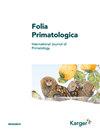The Use of Ultrasonic Communication to Maintain Social Cohesion in the Javan Slow Loris (Nycticebus javanicus)
IF 1.2
4区 生物学
Q2 ZOOLOGY
引用次数: 9
Abstract
Only a handful of primate taxa use ultrasonic vocalisations (those ≥20 kHz) to communicate. The extent and uses of ultrasonic communication remain poorly understood, potentially ranging from echolocation, advertisement of reproductive status and resource availability, social cohesion, to predator avoidance. Here, using active acoustics whereby the study subjects were observed throughout their activity period, we describe the first purely ultrasonic call from a strepsirrhine primate (family Lorisidae), recorded in a completely wild setting, and hypothesise about its function. We identified one type of ultrasonic call, the doublet click, from 14 Javan slow lorises (Nycticebus javanicus) produced by males and females of juvenile, subadult and adult ages within their social groups (n = 791, mean = 46.0 kHz). We ran quadratic discriminant function analysis, finding dominant frequency and doublet click duration as the key parameters for identifying individuals’ sex and age. Significantly more vocalisations were produced during affiliative social behaviour, suggesting that the call serves a social cohesion function. Considering the range of other cryptic behaviours, including slow and silent locomotion, and the high degree of territoriality associated with venomous attacks on conspecifics, the call may also serve as a safety strategy, allowing family members to regulate distance from other slow lorises and to communicate cryptically whilst avoiding predators.利用超声波交流维持爪哇懒猴的社会凝聚力
只有少数灵长类动物使用超声波发声(≥20千赫)进行交流。超声波通信的范围和用途仍然知之甚少,潜在的范围从回声定位、生殖状态和资源可用性的广告、社会凝聚力到捕食者的躲避。在这里,使用主动声学,即在整个活动期间观察研究对象,我们描述了在完全野生环境中记录的第一个来自链鼻灵长类动物(Lorisidae家族)的纯超声波呼叫,并假设其功能。从14只爪哇慢猴(Nycticebus javanicus)的幼猴、亚成年猴和成年猴(n = 791, mean = 46.0 kHz)中鉴定出一种双声鸣叫。我们进行了二次判别函数分析,发现主导频率和双击时长是识别个体性别和年龄的关键参数。在亲和的社会行为中产生的叫声明显更多,这表明这种叫声具有社会凝聚力功能。考虑到其他隐秘性行为的范围,包括缓慢和无声的运动,以及与对同种动物的毒性攻击相关的高度领土性,这种叫声也可能作为一种安全策略,允许家庭成员调节与其他慢懒猴的距离,并在躲避捕食者的同时进行隐秘性交流。
本文章由计算机程序翻译,如有差异,请以英文原文为准。
求助全文
约1分钟内获得全文
求助全文
来源期刊

Folia Primatologica
生物-动物学
CiteScore
3.30
自引率
10.50%
发文量
36
审稿时长
>12 weeks
期刊介绍:
Recognizing that research in human biology must be founded on a comparative knowledge of our closest relatives, this journal is the natural scientist''s ideal means of access to the best of current primate research. ''Folia Primatologica'' covers fields as diverse as molecular biology and social behaviour, and features articles on ecology, conservation, palaeontology, systematics and functional anatomy. In-depth articles and invited reviews are contributed by the world’s leading primatologists. In addition, special issues provide rapid peer-reviewed publication of conference proceedings. ''Folia Primatologica'' is one of the top-rated primatology publications and is acknowledged worldwide as a high-impact core journal for primatologists, zoologists and anthropologists.
 求助内容:
求助内容: 应助结果提醒方式:
应助结果提醒方式:


